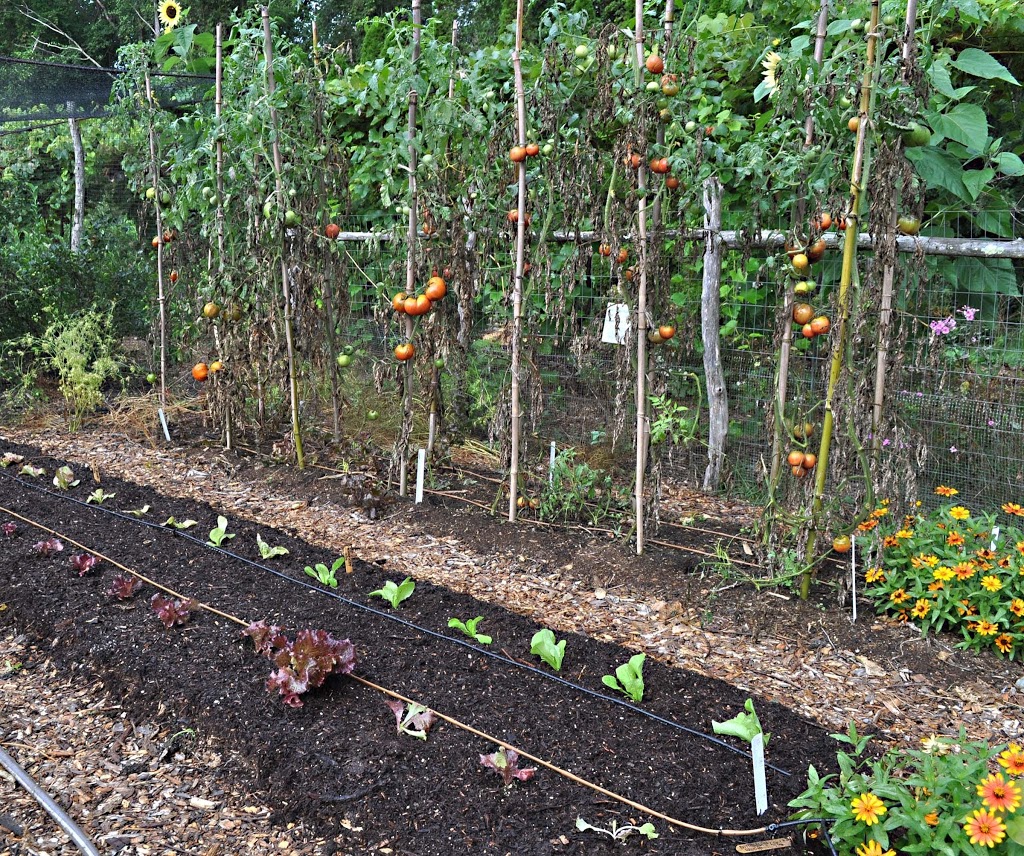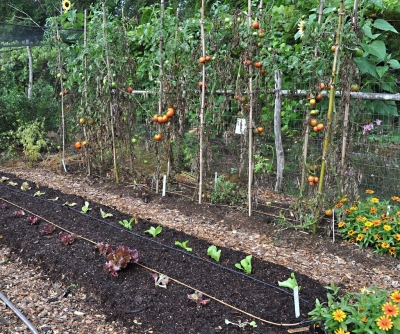One of the best things about no-till gardening is not having to till. The soil of my vegetable garden hasn’t been disturbed for over 2 decades. Besides avoiding the hassle of tilling, not having to till makes for quicker and easier planting.
Today, for instance, I planned to clear a bed of harvested edamame plants to make way for lettuce. Easy! I just pulled up each plant, coaxing it along, if necessary with a Hori Hori knife so that I had the tops and only the main roots in hand. Once plants were up and out, light use of a lawn rake gathered up dropped leaves, pods, and other debris, and brought what few weeds were still present into focus for removal. In 20 minutes, I had the double row of plants in a 20 foot by 3 foot wide bed cleared, and the bed cleaned up.
“Quicker and easier” are not the only benefits of no-till. Not tilling makes for less weeds because weed
seeds, buried within every soil, don’t get exposed to light, which they need to sprout. Untilled soils also make better use of water and maintain higher levels of organic matter.
I could have sown right into the clean surface but chose, instead to further enrich the ground for the months and year ahead. A garden line and sprinklings of ground limestone re-defined the edges of the beds, along which I laid two-by-fours. The two-by-fours, only temporary, were to contain the compost which I piled into the bed to a leveled depth of about an inch.
That one inch of compost provides all the fertility the bed needs for a year of vegetable production, even with multiple crops of vegetables in the bed. In addition to fertility, the compost helps the ground hold water and air, snuffs out small weed seedlings, and sustains beneficial soil organisms for healthier plants. Because the compost is made from “garbage,” fertility derived solely from compost is truly sustainable.
———————————————
Compost, as I wrote, makes for healthier plants. Thorough bed cleanup after each crop also makes for healthier plants by reducing sources of disease inoculum. (See my new compost video, www.youtube.com/leereichfarmden, for more about my compost making.)
That’s not to say that my garden has no pest problems. A pest problem arises when you have that perfect confluence of a susceptible plant, the presence of the pest, and a suitable environment. Susceptibility of a plant depends on the type of plant as well as how well it’s been nourished.
———————————————
All of which leads up to the admission, despite compost, pruning, and careful siting, that my tomato plants are not the picture of health. The plants, each pruned to a single stem that climbs, with the help of string ties, to a bamboo pole, have lost many of their lowermost leaves.
“Blight” is the mantra I keep hearing from other gardeners. Not so fast. Not every tomato affliction is
“blight,” a buzzword that originated, no doubt, with the “late blight” epidemic of a few years ago that sensitized gardeners and farmers to this disease. Late blight is but one of tomato’s enemies, but it’s not the only one.
Tomato plants bereft of leaves could be due to the diseases septoria leaf spot, early blight, or, of course, late blight, or the insect tomato hornworm. The hornworm is easily identified because it’s a big, fat, hungry caterpillar that chomps off big portions of healthy, green leaves. The caterpillar itself is quite a sight, as big as your thumb and with white stripes and eye-like markings along its length. Control is easy: crush them (unless they have parasites, which look like rice grains, attached to their backs) or spray using some commercial form of the biological insecticide Bacillus thuringiensis (Bt).
The three diseases are easily distinguished. Early blight marks leaves with spots of tan and black,concentric rings and yellowing leaf tissue. Septoria spots are small, round and gray, each surrounded by a single, dark margin. Late blight marks leaves with greenish-black splotches, each surrounded by a pale, greenish-yellow band. In humid weather, a downy growth develops on the undersides of leaves. On fruits, symptoms are firm, dark, greasy looking lesions.
My thorough cleanup and compost mulch greatly reduces presence of early blight and septoria leaf spot spores in the beginning of the season, as does planting tomatoes in a different location each year in a 3 year
 |
| Tomato hornworm with parasite |
rotation. Late blight needs living tissue to survive winter here, so returns by wintering over in infected potato tubers, by hopscotching up from the south on favorable winds with cool, moist weather, or, as happened a few years ago, by arriving on infected transplants sold by big box stores. I grow my own tomato seedlings and hope for the best as far as cooperative weather for my plants.
Taking a closer look at my tomato leaves, I see that the main causes for their defoliation are septoria leaf spot and — uh-oh — late blight. Weather in the next few weeks will determine how fast plants decline. I could spray (some formulation containing copper) but choose to avoid even mild pesticide, in this case. Upper portions of the plants still ook fine and, most importantly, I have been eating, canning, and drying plenty of tomatoes.





